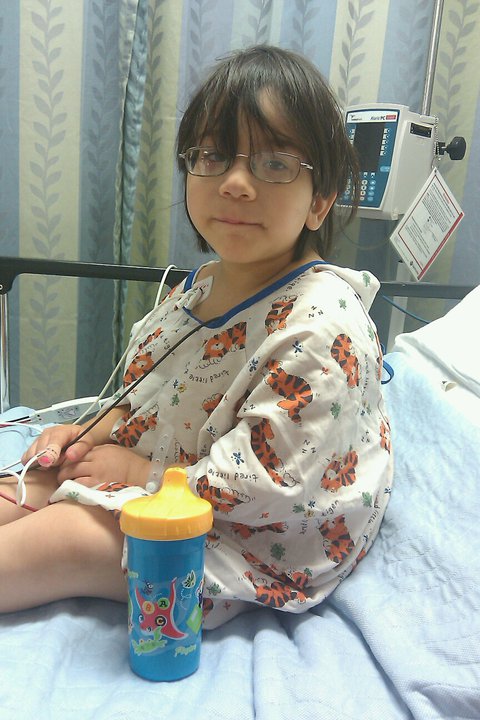|
|
Optimal Replacement for Hypopituitarism and Sheehan’s;
Oxytocin, testosterone, growth hormone, stimulants and beyond
Theodore C. Friedman, MD, PhD
December 6, 2023
This webinar is geared towards adult pan patients but information presented may pertain to the kids later in life.
|
 "The MAGIC Foundation gave me my sanity back. Our 13 y/o son was diagnosed with panhypopituitarism last year. Our endocrinologist is great, but finding The MAGIC Foundation and thru them, meeting other families dealing with the same or similar issues have given us additional information and the confidence we needed to get thru the initial emotions of his diagnosis. The people are fantastic and the yearly convention is a must. So thankful for this organization and the people behind it. I'll forever be grateful." Anonymous
"The MAGIC Foundation gave me my sanity back. Our 13 y/o son was diagnosed with panhypopituitarism last year. Our endocrinologist is great, but finding The MAGIC Foundation and thru them, meeting other families dealing with the same or similar issues have given us additional information and the confidence we needed to get thru the initial emotions of his diagnosis. The people are fantastic and the yearly convention is a must. So thankful for this organization and the people behind it. I'll forever be grateful." Anonymous
There are notable differences between the terms Hypopituitarism and Panhypopituitarism. Hypopituitarism is a rare condition that refers to a decrease of function of two or more hormones produced by the pituitary gland. When all pituitary hormone production is deficient or decreased, the term Panhypopituitarism is used. Both Hypopituitarism and Panhypopituitarism are very complicated. They involved many endocrine functions and hormones. This Introduction will help you understand the differences with specific details.
Etiology
-
Congenital Hypopituitarism usually presents occurs in early childhood. This may be due to birth trauma, or, Acquired.
-
Acquired Hypopituitarism in either children or adults may result from tumors, hydrocephalus or other mass effect, radiation or surgery to the head, trauma, vascular abnormalities, infiltrative disease and infarction or hemorrhage.
-
May also present with the following unique features:
-
Hypoglycemia (low blood sugar)
-
Microphallus (small penis in males)
-
Giant Cell Hepatitis, unique, non-infectious form of liver inflammation May result from any of several abnormal genes (PROP-1; PIT-1; POU1F1)
-
Optic Nerve Hypoplasia
-
May have no discernible cause (also called idiopathic)
-
Hypopituitarism is a rare condition, that occurs in between 1-1.5 per 100,000 individuals
Causes
To determine a specific cause for the hypopituitarism, a head MRI (with intravenous administration of contrast dye) must be performed. A CAT scan does not provide the same degree of resolution.
Causes of congenital (from birth) hypopituitarism that can be detected by MRI include a transected or interrupted hypothalamic-pituitary stalk and various midline defect syndromes (groupings of medical problems involving structures in the middle of the brain, such as septo-optic dysplasia, in which there may be absence of the midline brain structure known as the septum pellucidum and underdevelopment of the optic nerves associated with variable degrees of reduced vision).

Causes of acquired hypopituitarism that can be detected by MRI include tumors in the hypothalamic-pituitary region, the most common one of which in childhood is a craniopharyngioma. If there are no associated radiological abnormalities, the hypopituitarism is said to have an idiopathic basis.
Extent of Hypopituitarism
To characterize the extent of the hypopituitarism, appropriate testing for all clinically relevant pituitary hormones needs to be undertaken. Growth Hormone is the most commonly affected pituitary hormone in childhood hypopituitarism. Thus, the initial clue to the diagnosis of hypopituitarism is almost always short stature and slow growth, testing for which then confirms the diagnosis of Growth Hormone deficiency and begins the process of investigation for other hormonal deficiencies.
Deficiency of TSH causes central hypothyroidism (thyroid hormone deficiency). Unlike children whose hypothyroidism is due to thyroid gland damage, those with hypopituitarism typically have somewhat higher thyroid hormone levels and, thus, may have little or no symptoms, but sometimes present, like those patients with primary thyroid disease, with short stature and slow height velocity, relative weight excess, constipation, dry skin, and fatigue. A low total and/or free thyroxine (T4) level with a normal or low TSH level confirms the diagnosis of central hypothyroidism.
Younger children with deficiencies of the gonadotropins (luteinizing hormone = LH and follicle-stimulating hormone = FSH) show no abnormalities as, prior to puberty, these levels are normally very low. In contrast, older, adolescent-aged children with deficiencies of the gonadotropins present with failure to start or continue with puberty (breast development and menstrual periods in girls and enlargement of the penis and testicles in boys). During this age period, low levels of LH and FSH, along with a pelvic ultrasound in females that shows prepubertal-sized ovaries and uterus, may be diagnostic.
Loss of ACTH causes adrenal insufficiency (cortisol deficiency). This is the most likely hormone, if deficient, to place a child in a life-threatening situation. While there would likely be no symptoms under normal circumstances, except maybe mild fatigue, lack of ACTH and cortisol in the setting of infection, fever, surgery, etc., may cause vomiting, dehydration, shock, and even death. It is, therefore, imperative to have this hormonal system evaluated. Testing usually requires some sort of stimulation, such as with insulin, metyrapone, or low-dose ACTH.

ADH (also known as vasopressin) from the posterior or rear portion of the pituitary gland, if deficient, causes central or neurogenic diabetes insipidus (DI). Infants and toddlers manifest diabetes insipidus with excessively wet diapers. If unrecognized and, hence, untreated, in this age group, dehydration with elevated salt (sodium) concentrations in the blood ensues, as young children cannot report and easily satisfy heightened thirst. Older children with DI typically present with excessive day- and night-time urination, new onset of bed-wetting, and increased thirst. DI most often occurs unintentionally as a result of surgical treatment of a hypothalamic-pituitary tumor. In some cases, DI is temporary due to surgical swelling, but it will be permanent if surgical sacrifice close to the hypothalamus was required for complete cure of a brain tumor in the vicinity.
Functions of the Endocrine System
This is a complicated area to understand. Therefore, we have broken it up into several charts to help you grasp the details.
The Endocrine System as a whole:
-
Regulates body functions through the use of glands
-
Secretes substances into ducts to be carried to specific areas of the body
-
Secretes hormones that regulate activities of various body cells
Anatomy

The pituitary gland or master gland is a pea-shaped structure behind the eyes that hangs down on a stalk from the portion of the brain known as the hypothalamus. The pituitary gland contains two sections, an anterior [front] and posterior [rear]. The anterior section receives it signals through blood vessels arising in the hypothalamus and the posterior section receives its signals through nerves arising in the hypothalamus.
MAJOR GLANDS OF THE ENDOCRINE SYSTEM
The anterior portion of the pituitary, the adenohypophysis is derived from Rathke's pouch and receives regulatory signals from the hypothalamus through the portal system, resulting in the production of:
Pituitary: A pea-sized gland located at the base of the brain that regulates activities of other endocrine glands and controls body growth.
Thyroid: An H shaped gland in the front of the neck that secretes a hormone that controls the speed at which body cells work.
Parathyroid: Four small glands located behind the thyroid gland that regulate the calcium content of the blood.
Adrenal: Glands located on the kidneys that regulate the use of carbohydrates and salt, and prepare the body for emergencies by producing adrenaline.
Pancreas: A digestive gland that secretes pancreatic juice into the intestine and insulin into the bloodstream.
Ovaries: Female sex glands that produce ova and the female hormones estrogen and progesterone.
Testes: Male sex glands that produce sperm and the male hormone testosterone.
|
Where Hormone is Produced
|
Hormone(s) Secreted
|
Hormone Function
|
|
Pituitary Gland
|
GH (growth hormone)
|
Affects growth and development; stimulates protein production
|
|
Pituitary Gland
|
TSH (thyroid-stimulating hormone)
|
Stimulates the production and secretion of thyroid hormones
|
|
Pituitary Gland
|
ACTH (adrenocorticotropic hormone)
|
Controls adrenal production of cortisol which acts as an anti-inflammatory; maintains blood sugar levels and blood pressure. The most likely hormone, if deficient, to place a child in a life threatening situation.
|
|
Pituitary Gland
|
LH (luteinzing hormone) FSH (follicle-stimulating hormone)
|
Controls reproductive functioning and sexual characteristics
|
|
Pituitary Gland
|
Prolactin
|
Initiates and maintains milk production in breasts
|
|
While anterior pituitary dysfunction is more common, posterior pituitary disturbances may also be present. |
|
Pituitary Gland |
ADH (Anti Diuretic Hormone) |
Affects water retention in Kidneys; controls blood pressure DI-Diabetes insipidus-diagnosis is made based on the results of a formal water deprivation test. |
|
Pituitary Gland |
Oxytocin |
Stimulates contraction of uterus and milk ducts in the breast. |
Treatment of Panhypopituitarism
If an underlying cause for the childs hypopituitarism is found on the head MRI, directed therapy should be undertaken. For example, if a tumor is found, referral to a pediatric neurosurgeon is the first step. Similarly, if hydrocephalus (increased fluid build-up in the brain) is noted, the neurosurgeon needs to place a shunt to drain the extra fluid. In most cases, however, the treatment, while life-saving, does not reverse the hypopituitarism.

The management of childhood hypopituitarism is best supervised by a pediatric endocrinologist. The treatment of GH deficiency consists of replacement of GH by daily injection with a needle or pen system. A long-acting, once- or twice-monthly formulation has recently been approved by the FDA. Other delivery systems, such as intranasal administration, are being developed. The adequacy of treatment is generally determined by quarterly height measurements (using special measuring equipment known as a stadiometer) in the endocrinologists office.
Treatment of central hypothyroidism entails once-daily oral administration of oral levo-thyroxine (brand name or generic). The adequacy of treatment can generally be determined by annual measurements of total or free T4 (not TSH).
For older children, with proven deficiencies of gonadotroins, sex steroid replacement is required. In females, this consists of estrogen (oral or patch) and progesterone (oral) and, in boys, testosterone either as a long-acting shot in younger or older boys or as a patch or gel in older boys. The adequacy of treatment is best determined by clinical response and, in the case of testosterone replacement in males, by periodic blood testosterone measurements.
For treatment of adrenal insufficiency, oral hydrocortisone is given either two or three times daily and affected (older) child must wear Medic-Alert identification. The adequacy of treatment is best determined by general health as there are no specific blood tests for this purpose. To prevent an adrenal crisis secondary to unanticipated stress or illness, these doses should be doubled or tripled. Lastly, there should also be an injectable form of hydrocortisone available in the home.
Children with DI should be treated with either oral (pills) or intranasal DDAVP (either as a metered-pulse spray or as a solution given by rhinal tube into the nose). The adequacy of treatment is best determined on clinical grounds (i.e., frequency of urination); occasionally measurements of serum sodium can be helpful, especially in younger children.
Summary
Most cases of Panhypopituitarism [like those with isolated GH deficiency] are caused by diseases of the hypothalamus and its stalk resulting in a failure of the normal hypothalamic signals to reach the pituitary gland. Stated somewhat differently, the pituitary gland in these cases is frequently normal, but is unable to function properly because it does not receive the proper signals from the hypothalamus.

Hypopituitarism is a treatable condition in which affected patients should be able to have a normal life if appropriate hormone replacement therapy is given. Once adequate hormone replacement is established, does tend to remain stable, but long-term follow-up is necessary to monitor the efficacy and safety of these hormones, most of which will be required for the remainder of the patient's life. Follow-up with an endocrinologist is mandatory for the purposes of future medication dose adjustments, ongoing monitoring for efficacy and safety of the replaced hormones, and to address any special circumstances that arise, such as desire for fertility and management of intercurrent stress, or surgery.
Contributing Medical Specialist
Mitchell E. Geffner, M.D.
Professor of Pediatrics
Director, Fellowship Training and Education
Children's Hospital Los Angeles
Keck School of Medicine
University of Southern California
Information obtained from the following articles: HYPOPITUITARISM (IN ADULTS); Geffner, ME; Monzavi, R; WB Saunders Company, 2003 PANHYPOPITUITARISM IN CHILDHOOD; Geffner, ME
Resources
» Download a printable version of the Panhypopituitarism brochure
» Download Preventable Deaths: Panhypopituitarism & Adrenal Insufficiency brochure
» Download a printable version of the Dental Problems Associated with Growth Hormone Deficiency brochure
» Download a printable version of the Psychosocial Impact of Short Stature on Children and Adolescents
» Download a printable version of the Frequently Asked Questions when Beginning Growth Hormone Therapy brochure
» Click here for member benefits or to join The MAGIC Foundation
» "LIKE" The MAGIC Foundation's Facebook page
» Join our closed PAN Facebook group for parents or Join our PAN group for affected adults. After you request to join, please message an admin to gain access or email Erin at pan-tumor@magicfoundation.org
» Would you like to speak to someone about Panyhypopituitarism? If so, call The MAGIC Foundation at 800-3MAGIC3 or (630) 836-8200 or Email Us
For assistance outside North America, visit our International Coalition to see resources in your country